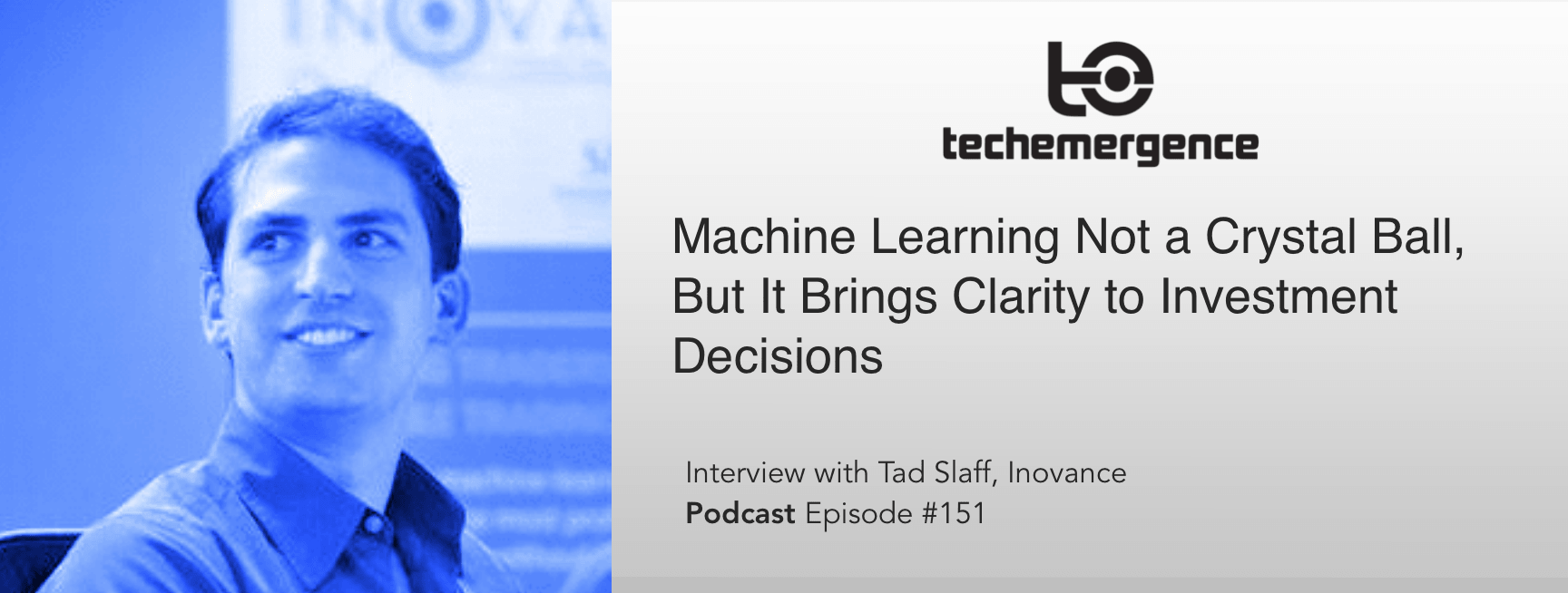
Episode Summary: Tad Slaff is the founder of Inovance Financial Technologies, the creator of TRAIDE – a strategy creation platform that uses machine learning algorithms to help traders uncover patterns in assets and indicators and build more reliable trading strategies. In this episode, Tad speaks about the state of machine learning in finance today, and touches on how future applications of machine learning and trends may alter what gives an edge to one hedge fund or institutional investor over another.
Expertise: Machine learning and quantitative finance
Recognition in Brief: Tad Slaff graduated from the University of Colorado Boulder before co-founding Inovance Financial Technologies. Before Inovance, Tad was developing systematic, quantitative strategies trading the financial markets. He is also co-founder of HNN Technologies, a platform for spot foreign exchange retail traders.
Current Affiliations: Founder/EVP Development at Inovance Financial Technologies
Leveraging More Open Machine Learning
Machine learning has become more accessible in many industries within the last few years, and that includes in the often closed-doors world of finance. Though machine algorithms have been used in finance for more than a decade, use of such methods was typically limited to those using quant funds, teams trying to get as much data as possible (before big data was a buzz word) and analyze the information to determine best trading strategies.
No new news that we have loads of data, but the real and still formidable question is, how can we turn such data into something useful and valuable? In finance, open source libraries have begun popping up, and a lot of brokers are opening up their platform APIs so that more investors can bring in their own proprietary data and trade in an automated fashion, skirting the previous investment of time and funds that used to go into the development of sophisticated trading strategies.
Despite great advances, one of the big knocks on AI in general is that it has trouble living up to unrealistic expectations.
“People think it’s going to be this magical black box that spits out a desired output, whether it’s a trade recommendation or the perfect chess play, but to get to that point requires hard work,” says Tad.
We’re still at the beginning of the machine learning road, with algorithms being applied to ‘simpler’ problems, such as finding better ways to optimize existing models. “But in terms of building an AI that can trade for me, we’re nowhere close to that being accessible,” posits Slaff. He does note that there are plenty of FinTech experts experimenting with things like neural networks and support vector machines, even feature learning, in the finance world.
Human intuition and the way that traders analyze the market is incredibly valuable, and the importance of that intuition cannot be underestimated or replaced (or at least, not anytime in the foreseeable future). Tad (and arguably others like) him are trying to leverage what individual humans are good at (creativity) and combine their innovation with machine learning strengths (finding patterns and information in large data sets). Such 21st century collaborations are turning out new interfaces where traders can frame questions and theories, then feed the data that they think is interesting into an algorithm, which can then transform that data and return it in a form that the trader can better understand.
With these new innovations emerge ripe competitive advantages, such as increasing open access to proprietary data resources. A second, less intuitive area, is the process or the strategy level of optimizing trades, and the collaborative power of machine and human input matters. This is where a lot more companies are spending resources and how traders are judging one model over the next – how well the entire process translates into a trade, says Tad. It’s not necessarily about who has the best, ‘all-knowing’ algorithm, but rather how to formulate the best strategic process for building, testing, measuring and implementing algorithms in an efficient manner, using both machine and human power.
The best final product, in other words, is a much more complex machine than a single algorithm. Collaborative machine-human approaches are already starting to propagate in other industries that don’t necessarily have a history of using machine learning (like eCommerce), but where analyzing and optimizing performance and behavioral models is key to surviving in a competitive environment.
Future FinTech Projections
Already, a vast majority of decisions are generated by computers trading against each other, but Tad wouldn’t go so far as to call these machine learning applications. Unlike some other industries that have a lot of catching up to do and hence some new hesitations, the financial world has been ruled by computers for some time, with roots reaching back to the 1970s and the the New York Stock Exchange’s “designated order turnaround” system (DOT, and later SuperDOT).
Looking ahead into the next half decade, Slaff see major changes that could emerge on two levels. The first is the way that algorithms are built, tested, and run, which he believes will require less human supervision in a lot of broader AI applications; this may lead into building other trading robots that start taking over for humans, a kind of robo-adviser or broker. A second level where Tad sees change likely to occur is on the side of the individual investor.
“There’s a delicate balance between transparency and really trust because if I have an application and am not sure how it’s arriving at a decision…I really need a lot of help when putting my own money behind it,” he says. High risk scenarios require trust, and as a result he believes we’ll start to see more of a Siri-type application, a virtual assistant that is geared more towards the investor and trader, which can provide analysis and be able to articulate how the system arrived at its conclusion.
“It really comes down to the idea of transparency and trust, where you know the information that is being presented to you, you can understand it to some level what the analysis is behind it and still have enough faith to act on that or at least make an informed decision that gives you the best probability of success,” says Slaff.
Tad’s ultimate goal with Inovance is to get investors to the stage where they feel comfortable trading and using machines as a trustworthy partner, or at least to help accelerate that process.
Image credit: Charlotte Business Journal











